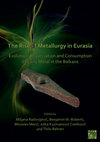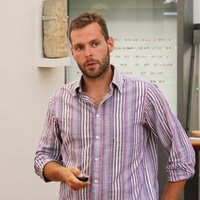Papers by Vidan Dimic
Documenta Praehistorica 51, 2024
Ground and abrasive stone tools had a long, dynamic and complex life during which they could repe... more Ground and abrasive stone tools had a long, dynamic and complex life during which they could repeatedly pass through different segments of the operational chain until their final disposal. Those tools would wear out slowly and could be used for a long time with constant renewal. Even after being damaged, they would start a new life cycle through various recycling processes or in a secondary context. The aim of this paper is to consider the transformative processes within the ground and abrasive stone industry in the Neolithic of Serbia and clarify their use in terms of maintenance, secondary use, and recycling, as well as to show the most frequent examples of such technological practices. The focus is primarily on tools for everyday use and the ways in which they were rerouted through various segments of the operational chain.

Arheologija u Srbiji. Projekti Arheološkog instituta u 2020. godini, 2023
Višegodišnja arheološka istraživanja lokaliteta Prljuša-Mali Šturac1, pokazala su da se na ovoj s... more Višegodišnja arheološka istraživanja lokaliteta Prljuša-Mali Šturac1, pokazala su da se na ovoj strmoj, goloj i nadaleko uočljivoj padini planine Rudnik nalazi jedan od najvećih i najbogatijih lokaliteta rudarskog karaktera u jugoistočnoj Evropi, na kome je u periodu od eneolita do bronzanog doba vršena eksploatacija malahita. Iskopavanja su od 2013. godine bila fokusirana na površinske rudarske radove na centralnom delu padine (okna 4 i 6; Antonović et al. 2014; Antonović 2017), dok je 2014. godine fokus pomeren na vrh padine, i na, kako se kasnijim istraživanjima ispostavilo, impozantno okno Objekat 1 (Antonović, Dimić 2017; Antonović et al. 2018, 2019, Antonović et al. 2021a, 2021b). Višegodišnja i kontiuirana istraživanja ove celine i otkrića više galerija u nizu, hodnika, ulaza, tragova paljevine, udaranja i razbijanja na steni itd., doprinela su da saznanja o načinu praistorijske eksploatacije bakarne rude na ovoj lokaciji budu potpunija. Godine 2019. započeto je i uređenje prostora oko Objekta 1, sa ciljem da se ovaj rudarski kompleks prezentuje široj javnosti i na taj način podstakne postepeno stvaranje svojevrsnog muzeja na otvorenom kakvih samo nekoliko postoji u Evropi (sl. 1) (Антоновић et al. 2020).2 Kako se tokom prethodnih istraživanja iskop širio od istoka ka zapadu, prateći i širenje samog okna, njegova severna granica ostala je neistražena, a ogromna količina zemlje i kamenja u tom pojasu je pretila da se obruši u otkrivene galerije predviđene za prezentaciju. Zato su arheološki radovi iz 2019, a potom i 2020. godine3 (sl. 2) imali sistematsko-zaštitni karakter, pri čemu je fokus stavljen na otkrivanje, definisanje i stabilizovanje severne granice okna Objekat 1, čime bi istraživanje ovog okna kao celine bilo zaokruženo, nanos zemlje i kamenja uklonjen, a sam iskop uređen i osiguran.

Radivojević, M., Roberts, B. W., Marić, M., Kuzmanović Cvetković, J., & Rehren, Th. (Eds.). (2021). The Rise of Metallurgy in Eurasia: Evolution, Organisation and Consumption of Early Metal in the Balkans. Oxford: Archaeopress. by Miljana Radivojević, Thilo Rehren, Benjamin Roberts, Neda Mirković-Marić, Patrick Mertl, Milica Rajicic, Silvia Amicone, Vidan Dimic, Dragana Filipovic, Jelena Bulatović, Marko Porčić, Enrica Bonato, and Ernst Pernicka The Rise of Metallurgy in Eurasia: Evolution, Organisation and Consumption of Early Metal in the Balkans, 2021
The Rise of Metallurgy in Eurasia is a landmark study in the origins of metallurgy. The project a... more The Rise of Metallurgy in Eurasia is a landmark study in the origins of metallurgy. The project aimed to trace the invention and innovation of metallurgy in the Balkans. It combined targeted excavations and surveys with extensive scientific analyses at two Neolithic-Chalcolithic copper production and consumption sites, Belovode and Pločnik, in Serbia. At Belovode, the project revealed chronologically and contextually secure evidence for copper smelting in the 49th century BC. This confirms the earlier interpretation of c. 7000-year-old metallurgy at the site, making it the earliest record of fully developed metallurgical activity in the world. However, far from being a rare and elite practice, metallurgy at both Belovode and Pločnik is demonstrated to have been a common and communal craft activity.
This monograph reviews the pre-existing scholarship on early metallurgy in the Balkans. It subsequently presents detailed results from the excavations, surveys and scientific analyses conducted at Belovode and Pločnik. These are followed by new and up-to-date regional syntheses by leading specialists on the Neolithic-Chalcolithic material culture, technologies, settlement and subsistence practices in the Central Balkans. Finally, the monograph places the project results in the context of major debates surrounding early metallurgy in Eurasia before proposing a new agenda for global early metallurgy studies.
Open access and fully downloadable from:
https://doi.org/10.32028/9781803270425
Glasnik Društva konzervatora Srbije 44, 2020

Glasnik Srpskog arheološkog duštva, 2020
Eкспериментална археологија је као поддисциплина археологије дефинисана шездесетих година 20. век... more Eкспериментална археологија је као поддисциплина археологије дефинисана шездесетих година 20. века, међутим, њени зачеци се могу видети још у 19. веку. Развој експерименталне археологије одсликава и теоријско-методолошке промене кроз које је пролазила целокупна археологија. Експериментална археологија је прошла кроз бројне трансформације-од појединачних експеримената у 19. веку и првој половини 20. века, преко дефинисања теоријско-методолошког оквира, све до данашњих дана. Будући да се најпотпунији подаци могу добити приликом спровођења комплексних експеримена-та, у којима учествује велики број стручњака из различитих области археологије, у другој половини 20. формирају се истраживачки центри експерименталне археологије. У оваквим центрима, експериментални археолози праве читава насеља из различитих периода прошлости. Атрактивност ових насеља и могућност практичног преноса зна-ња на ширу јавност отвара ова насеља за посетиоце. Ствара се нови концепт музеја-археолошки музеј на отвореном, чији број расте из године у годину. Интересовање за откривање живота у прошлости расте, те поред музеја на отвореном, јављају се и бројне емисије, а у последњих неоколико година, и специјализовани јутјуб канали који се баве традиционалним занатима. На тај начин, из експерименталне археологије на-стаје искуствена археологија, чији је фокус управо у преносу знања преко личних до-живљаја, како археолога, тако и шире јавности. Циљ овог рада је да се прикаже развој експерименталне и искуствене археологије, како у свету, тако и у Србији.
Aktuelna interdiscplinarna istraživanja tehnologije u arheologiji jugoistočne Evrope : zbornik radova/Current Interdisciplinary Studies in Technology in the Archaeology of the South-East Europe, 2020

Starinar, 2019
The locality of Prljuša–Mali Šturac on Rudnik Mountain is one of the richest prehistoric mining s... more The locality of Prljuša–Mali Šturac on Rudnik Mountain is one of the richest prehistoric mining sites in Europe,
taking into account the number of recorded, collected and analysed mining hammerstones. The reasonably estimated number
of these tools of 2,000 and more clearly depicts the intensity of prehistoric mining activities at this locality as well as the
conspicuousness of the mining potential which this mountain possessed. During the archaeological research conducted so far,
688 hammerstones have been collected and analysed (of which 478 are from recent excavation campaigns), thus producing
results based on which hypotheses were made regarding their manufacture and use. Consequently, in the summer of 2017,
an experimental (re)construction was undertaken on three basic types of these tools, as a complementary segment to a set of
functional and typological analyses. The goal of the experimental research was to enable and gather as much as possible data
that would serve as a comparative filter for testing previously set hypotheses and research questions related to the manufacture
and usage modes of this category of mining tools. The mining hammerstones made for the purpose of this experiment proved
to be extensively efficient in practice. The obtained results enabled a more complete understanding of the prehistoric mining
technology on this site, but also raised some new questions.

Abstract: The recent investigations at the late Neolithic settlement at Vinča-Belo Brdo (1998–200... more Abstract: The recent investigations at the late Neolithic settlement at Vinča-Belo Brdo (1998–2007) in Serbia provided an opportunity for a detailed study of the special disposition of artefacts, and work operations from the latest phase of the Vinča community. We conducted series of experiments as a complementary segment to the standard package of technological-typological and petro-archaeological analyses of chipped stone artefacts recovered from the latest archaeological campaigns. We present the stages and the results of the experiments related to two aspects of our research: 1) production of two replicas
of the prehistoric composite sickles and microscopic analysis of use-wear left after harvesting of cereals; 2) experimental cultivation and harvesting of ancient cereal species/varieties using replicas of prehistoric sickles. Images of blades were taken after each recorded work cycle, used to study traces and use-wear observed on archaeological specimens. The sickle replicas proved to be effective and durable tools that could be used for more than one season of harvesting. The quantifiable data of all stages of growing and harvesting of cereals with prehistoric tool replicas, provide important new information about activities involving mobilization of a larger number of people, essential for a better understanding of the activities and organization of prehistoric communities.
International Symposium of Arcaheology Vita est Vita 4, Acta Musei Tiberiopolitani, vol 2. , 2017
In the Neolithic and Early Eneolithic in the Central Balkans, the white colour seems to have had ... more In the Neolithic and Early Eneolithic in the Central Balkans, the white colour seems to have had a particular importance. White stones were commonly used for production of cult and decorative objects, and in the late phase of the Vinča culture even for tools. Osseous raw materials, naturally white or whitish, were used for daily tools but they were also the preferred raw material for decorative items. The aim of this paper is to present the importance of the white colour and to give possible answers to the question on the significance and meaning of the white colour to inhabitants of the Central Balkans.
Апстракт
:
Приликом рекогносцирања палеолитских налазишта на отвореном простору на североисточни... more Апстракт
:
Приликом рекогносцирања палеолитских налазишта на отвореном простору на североисточним обронцима Гоча, евидентирано је неколико локалитета из овог периода. Локалитети су констатовани на обронцима узвишења на којима се јављају примарна лежишта рожнаца, на терасама у сливу Попинске реке, и на другој плеистоценској тераси (t2) Западне Мораве. На основу заступље-ности карактеристичних производа окресивања и типова оруђа, установљено је да налазишта у близини лежишта сировина и околине Дубља садрже остатке из доњег, а можда и средњег палеолита, док налазишта у Руђинцима вероватно припадају средњем палеолиту. Заступљеност бифацијалних елемената и секача типа „cleaver” наговештава могућност да се на овом подручју јављају и ашелска налазишта, али ће та претпоставка моћи да буде потврђена тек када типични ашелски бифаси буду нађени у сигурном стратиграфском контексту
Апстракт
:
Дефинисање јасних терминолошких одредница и проблеми интерпре-тације део су сваког је... more Апстракт
:
Дефинисање јасних терминолошких одредница и проблеми интерпре-тације део су сваког језика или науке од којих не одступа ни археологија. Ситуација постаје сложенија када се придодају проблеми превођења, тумачења, корелације и егализације страних термина са онима из нашег језика. Циљ овог рада управо је презентовање појединих терминолошких потешкоћа и интерпретативних недоумица са којима се истраживачи глачане камене индустрије свакодневно сусрећу. Оне се односе на тумачење појединих појмова како у нашем, тако и у енглеском језику, на ближе схватање археолошке класификације „лаких белих стена”, затим на тумачење више технолошких ступњева у изради једне алатке, тј. на различите облике „полуфабриката”, као и на презентовање, за ове просторе, новог типа алатке – растирача у облику „векне хлеба”.
This paper represents a traseological study of edge–ground stone tools based on the assemblage of... more This paper represents a traseological study of edge–ground stone tools based on the assemblage of artifacts from archeological excavations of the Neolithic site of Lađariste , conducted in the period from 1987 until 1990, which is being kept in the Local Heritage Museum in Vrnjačka Banja. Also, analysis includes artifacts of the same catego-ry which were collected during a reconnaissance of this site, as well as artifacts obtained by purchase. The aim of this study is to provide data, which would add to the previous knowledge of this tool category on the local level, as well as over a wider area. These data relate to traselogical markers spotted on ground stone tools with cutting edge, obtained: during the production of the very artifact, as well as with its practical use. This analysis gathers all those artifacts which provided minimum indications for this kind of research
Conference Presentations by Vidan Dimic

СРПСКО АРХЕОЛОШКО ДРУШТВО XLV СКУПШТИНА И ГОДИШЊИ СКУП Прокупље, 26. – 28. мај 2022. године, 2022
Године 2021. Археолошки институт покренуо је пројекат „Систематско рекогносцирање праисторије Руд... more Године 2021. Археолошки институт покренуо је пројекат „Систематско рекогносцирање праисторије Рудника и околине“, са циљем да се детаљним прегледом терена покрију раније недовољно истражени аспекти насељавања и коришћења простора током праисторије у рудничкој области. На планини Рудник се већ дуги низ година истражује праисторијски рудник малахита Прљуша – Мали Штурац, једини такав рудник у Шумадији, али нису позната насеља рудара који су користили овај рудник, нити су довољно истражени други извори минералних сировина у овој области. Током 2021. године рекогносцирања су обављена на територијама које припадају граду Крагујевцу и општини Кнић. Од посебног значаја биле су локације Рамаћа, Рогојевац и Вучковица.
Рамаћа је локација која је у ранијој археолошкој литератури означена као место одакле су различите праисторијске заједнице експлоатисале камен. У близини села Рамаћа данас се експлоатишу два изворишта камених сировина, међутим, обиласком терена нису уочени трагови праисторијске експлоатације, што може бити и зато што су уништени савременом експлоатацијом. Обилазак околног терена такође није дао резултате, тако да питање коришћења Рамаће остаје отворено. Прикупљени су петрографски узорци, који ће бити накнадно анализирани.
У близини села Рогојевац налази се велики каменолом квалитетног кремена. Опет, на самом каменолому трагови праисторијске експлоатације нису уочени. У близини каменолома, на потезу Камаре, нађени су на површини фрагменти праисторијске керамике.
Каменолом Вучковица такође је потенцијално место експлоатације камена у праисторији, што ће бити проверено када петрографски узорци буду анализирани. Фрагменти праисторијске керамике су нађени у близини каменолома.
Даљим истраживањима биће проверени и други подаци, и надамо се добијени нови, о експлоатацији различитих минералних сировина током праисторије у рудничкој области.

XLII СКУПШТИНА И ГОДИШЊИ СКУП Српско археолошко друштво , 2019
Технолошка прошлост човечанства чини битан сегмент праисторијске археологије – начин на који су с... more Технолошка прошлост човечанства чини битан сегмент праисторијске археологије – начин на који су се експлоатисале поједине сировине, како су се прерађивале и употребљавале сведоче не само о организацији производње и активностима датих праисторијских заједница, већ и пружају податке о односу према околини, као и ширим друштвеним и економским односима. Почеци прераде металних сировина сматрају се изуетно значајним тренутком људске прошлости, прекретницом која је даље условила специјализовано занатство, раслојавање у друштву и друге друштвено-економске промене које су заувек измениле људско друштво. За адекватну анализу почетака металургије код праисторијских заједница, међутим, потребан је и свеобухватан приступ. У овом раду аутори ће се дати преглед теоријских и методолошких приступа анализама почетака металургије. Студије технологије, како су предложили различити антрополози, посебно Пјер Лемоније и Брајан Фафенбергер, подразумевају сагледавање појаве, прихватања и ширења нове технологије у ширем друштвеном контексту. Ови аутори нарочито инсистирају на анализи вишеструких технологија (multiple technologies), односно на свеобухватној анализи различитих технологија, које чине технолошке системе, са посебним освртом на то како промене у једној технологији утичу на друге. Кад се ради о проучавању почетака експлоатације металних руда и њихове прераде, то подразумева проучавање налаза метала у пре-металичним фазама (као што су предмети од малахита из периода неолита), њиховог контекта и значаја, проучавање промена у коштаној и каменој индустрији током енеолита и раног бронзаног доба, и друго.

In summer of 1974 preventive excavations were made by Anton Nițu and Paul Șadurschi on the Prut r... more In summer of 1974 preventive excavations were made by Anton Nițu and Paul Șadurschi on the Prut river terrace, at the site Stânca Doamnei from Stânca-Costești, Botoșani County, Romania. Here were excavated four houses and six pits. Inside House 3 was found a cross-shaped hearth, mentioned in the preliminary report published by the two researchers, without discussing the complete context, objects associated and the meanings of this feature. Considering the importance of such a feature for the European Eneolithic, we discuss this cross-shaped hearth with all the elements associated, considering also the Cucuteni cultural context and the analogies. The cross shaped hearts are quite rare, and the few examples we know from the Cucuteni-Trypillya area, are showing the cultic and religious meanings of such feature. In Botoşani County Museum are displayed several statuettes from this site, of different shapes and sizes. These were never published. Our presentation is related to the reconsideration of these old excavations and the interpretation of them, considering the archaeological context and the related analogies from the same time frame.











Uploads
Papers by Vidan Dimic
This monograph reviews the pre-existing scholarship on early metallurgy in the Balkans. It subsequently presents detailed results from the excavations, surveys and scientific analyses conducted at Belovode and Pločnik. These are followed by new and up-to-date regional syntheses by leading specialists on the Neolithic-Chalcolithic material culture, technologies, settlement and subsistence practices in the Central Balkans. Finally, the monograph places the project results in the context of major debates surrounding early metallurgy in Eurasia before proposing a new agenda for global early metallurgy studies.
Open access and fully downloadable from:
https://doi.org/10.32028/9781803270425
taking into account the number of recorded, collected and analysed mining hammerstones. The reasonably estimated number
of these tools of 2,000 and more clearly depicts the intensity of prehistoric mining activities at this locality as well as the
conspicuousness of the mining potential which this mountain possessed. During the archaeological research conducted so far,
688 hammerstones have been collected and analysed (of which 478 are from recent excavation campaigns), thus producing
results based on which hypotheses were made regarding their manufacture and use. Consequently, in the summer of 2017,
an experimental (re)construction was undertaken on three basic types of these tools, as a complementary segment to a set of
functional and typological analyses. The goal of the experimental research was to enable and gather as much as possible data
that would serve as a comparative filter for testing previously set hypotheses and research questions related to the manufacture
and usage modes of this category of mining tools. The mining hammerstones made for the purpose of this experiment proved
to be extensively efficient in practice. The obtained results enabled a more complete understanding of the prehistoric mining
technology on this site, but also raised some new questions.
of the prehistoric composite sickles and microscopic analysis of use-wear left after harvesting of cereals; 2) experimental cultivation and harvesting of ancient cereal species/varieties using replicas of prehistoric sickles. Images of blades were taken after each recorded work cycle, used to study traces and use-wear observed on archaeological specimens. The sickle replicas proved to be effective and durable tools that could be used for more than one season of harvesting. The quantifiable data of all stages of growing and harvesting of cereals with prehistoric tool replicas, provide important new information about activities involving mobilization of a larger number of people, essential for a better understanding of the activities and organization of prehistoric communities.
:
Приликом рекогносцирања палеолитских налазишта на отвореном простору на североисточним обронцима Гоча, евидентирано је неколико локалитета из овог периода. Локалитети су констатовани на обронцима узвишења на којима се јављају примарна лежишта рожнаца, на терасама у сливу Попинске реке, и на другој плеистоценској тераси (t2) Западне Мораве. На основу заступље-ности карактеристичних производа окресивања и типова оруђа, установљено је да налазишта у близини лежишта сировина и околине Дубља садрже остатке из доњег, а можда и средњег палеолита, док налазишта у Руђинцима вероватно припадају средњем палеолиту. Заступљеност бифацијалних елемената и секача типа „cleaver” наговештава могућност да се на овом подручју јављају и ашелска налазишта, али ће та претпоставка моћи да буде потврђена тек када типични ашелски бифаси буду нађени у сигурном стратиграфском контексту
:
Дефинисање јасних терминолошких одредница и проблеми интерпре-тације део су сваког језика или науке од којих не одступа ни археологија. Ситуација постаје сложенија када се придодају проблеми превођења, тумачења, корелације и егализације страних термина са онима из нашег језика. Циљ овог рада управо је презентовање појединих терминолошких потешкоћа и интерпретативних недоумица са којима се истраживачи глачане камене индустрије свакодневно сусрећу. Оне се односе на тумачење појединих појмова како у нашем, тако и у енглеском језику, на ближе схватање археолошке класификације „лаких белих стена”, затим на тумачење више технолошких ступњева у изради једне алатке, тј. на различите облике „полуфабриката”, као и на презентовање, за ове просторе, новог типа алатке – растирача у облику „векне хлеба”.
Conference Presentations by Vidan Dimic
Рамаћа је локација која је у ранијој археолошкој литератури означена као место одакле су различите праисторијске заједнице експлоатисале камен. У близини села Рамаћа данас се експлоатишу два изворишта камених сировина, међутим, обиласком терена нису уочени трагови праисторијске експлоатације, што може бити и зато што су уништени савременом експлоатацијом. Обилазак околног терена такође није дао резултате, тако да питање коришћења Рамаће остаје отворено. Прикупљени су петрографски узорци, који ће бити накнадно анализирани.
У близини села Рогојевац налази се велики каменолом квалитетног кремена. Опет, на самом каменолому трагови праисторијске експлоатације нису уочени. У близини каменолома, на потезу Камаре, нађени су на површини фрагменти праисторијске керамике.
Каменолом Вучковица такође је потенцијално место експлоатације камена у праисторији, што ће бити проверено када петрографски узорци буду анализирани. Фрагменти праисторијске керамике су нађени у близини каменолома.
Даљим истраживањима биће проверени и други подаци, и надамо се добијени нови, о експлоатацији различитих минералних сировина током праисторије у рудничкој области.
This monograph reviews the pre-existing scholarship on early metallurgy in the Balkans. It subsequently presents detailed results from the excavations, surveys and scientific analyses conducted at Belovode and Pločnik. These are followed by new and up-to-date regional syntheses by leading specialists on the Neolithic-Chalcolithic material culture, technologies, settlement and subsistence practices in the Central Balkans. Finally, the monograph places the project results in the context of major debates surrounding early metallurgy in Eurasia before proposing a new agenda for global early metallurgy studies.
Open access and fully downloadable from:
https://doi.org/10.32028/9781803270425
taking into account the number of recorded, collected and analysed mining hammerstones. The reasonably estimated number
of these tools of 2,000 and more clearly depicts the intensity of prehistoric mining activities at this locality as well as the
conspicuousness of the mining potential which this mountain possessed. During the archaeological research conducted so far,
688 hammerstones have been collected and analysed (of which 478 are from recent excavation campaigns), thus producing
results based on which hypotheses were made regarding their manufacture and use. Consequently, in the summer of 2017,
an experimental (re)construction was undertaken on three basic types of these tools, as a complementary segment to a set of
functional and typological analyses. The goal of the experimental research was to enable and gather as much as possible data
that would serve as a comparative filter for testing previously set hypotheses and research questions related to the manufacture
and usage modes of this category of mining tools. The mining hammerstones made for the purpose of this experiment proved
to be extensively efficient in practice. The obtained results enabled a more complete understanding of the prehistoric mining
technology on this site, but also raised some new questions.
of the prehistoric composite sickles and microscopic analysis of use-wear left after harvesting of cereals; 2) experimental cultivation and harvesting of ancient cereal species/varieties using replicas of prehistoric sickles. Images of blades were taken after each recorded work cycle, used to study traces and use-wear observed on archaeological specimens. The sickle replicas proved to be effective and durable tools that could be used for more than one season of harvesting. The quantifiable data of all stages of growing and harvesting of cereals with prehistoric tool replicas, provide important new information about activities involving mobilization of a larger number of people, essential for a better understanding of the activities and organization of prehistoric communities.
:
Приликом рекогносцирања палеолитских налазишта на отвореном простору на североисточним обронцима Гоча, евидентирано је неколико локалитета из овог периода. Локалитети су констатовани на обронцима узвишења на којима се јављају примарна лежишта рожнаца, на терасама у сливу Попинске реке, и на другој плеистоценској тераси (t2) Западне Мораве. На основу заступље-ности карактеристичних производа окресивања и типова оруђа, установљено је да налазишта у близини лежишта сировина и околине Дубља садрже остатке из доњег, а можда и средњег палеолита, док налазишта у Руђинцима вероватно припадају средњем палеолиту. Заступљеност бифацијалних елемената и секача типа „cleaver” наговештава могућност да се на овом подручју јављају и ашелска налазишта, али ће та претпоставка моћи да буде потврђена тек када типични ашелски бифаси буду нађени у сигурном стратиграфском контексту
:
Дефинисање јасних терминолошких одредница и проблеми интерпре-тације део су сваког језика или науке од којих не одступа ни археологија. Ситуација постаје сложенија када се придодају проблеми превођења, тумачења, корелације и егализације страних термина са онима из нашег језика. Циљ овог рада управо је презентовање појединих терминолошких потешкоћа и интерпретативних недоумица са којима се истраживачи глачане камене индустрије свакодневно сусрећу. Оне се односе на тумачење појединих појмова како у нашем, тако и у енглеском језику, на ближе схватање археолошке класификације „лаких белих стена”, затим на тумачење више технолошких ступњева у изради једне алатке, тј. на различите облике „полуфабриката”, као и на презентовање, за ове просторе, новог типа алатке – растирача у облику „векне хлеба”.
Рамаћа је локација која је у ранијој археолошкој литератури означена као место одакле су различите праисторијске заједнице експлоатисале камен. У близини села Рамаћа данас се експлоатишу два изворишта камених сировина, међутим, обиласком терена нису уочени трагови праисторијске експлоатације, што може бити и зато што су уништени савременом експлоатацијом. Обилазак околног терена такође није дао резултате, тако да питање коришћења Рамаће остаје отворено. Прикупљени су петрографски узорци, који ће бити накнадно анализирани.
У близини села Рогојевац налази се велики каменолом квалитетног кремена. Опет, на самом каменолому трагови праисторијске експлоатације нису уочени. У близини каменолома, на потезу Камаре, нађени су на површини фрагменти праисторијске керамике.
Каменолом Вучковица такође је потенцијално место експлоатације камена у праисторији, што ће бити проверено када петрографски узорци буду анализирани. Фрагменти праисторијске керамике су нађени у близини каменолома.
Даљим истраживањима биће проверени и други подаци, и надамо се добијени нови, о експлоатацији различитих минералних сировина током праисторије у рудничкој области.
area, northeastern Serbia) is chronologically contemporaneous with the Starčevo horizon at Lepenski Vir,
and it is located in its immediate vicinity. Our analysis of the stone tools encompassed the material from
trench 1–2/2005, investigated in 2005 and 2006. Judging on the basis of the ground stone assemblage from
this site, and with the same conclusion reached based on the ceramic analysis, a rural household was
identified in this place, in a small settlement with dispersed dug-in features, typical of the Starčevo
culture. In this household, the every-day life of the community was probably focused on farming. There
were items found which were used for food preparation – aside from pottery, such as stone querns – but
there were also tools and household items produced from materials softer than stone, such as wood and
bone, which were not preserved. Various fragments of raw material, not so numerous in this assemblage,
indirectly point to a small-scale ground stone tool production at this place. The secondary use of
fragmented abrasive tools bears witness to, in most cases, expedient tools used by the inhabitants of this
household. It is probable that in the mountainous hinterland of the Early Neolithic sites discovered along
the Danube’s banks in this region existed smaller villages which provided both agricultural and perhaps
also some artisanal products.